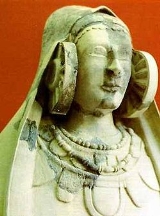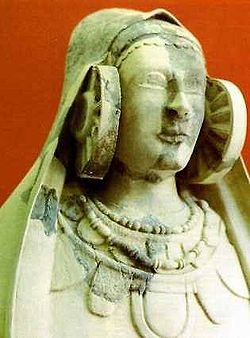
Lady of Guardamar
Encyclopedia
Lady of Guardamar also known as the Lady of Cabezo Lucero, is a limestone female bust, 50 cm high, dated circa 400 BC, that was discovered in fragments in the Phoenecian archaeological site of Cabezo Lucero in Guardamar del Segura
in Alicante
province, Spain
, on September 22, 1987.
 A large piece of a stone rodete (wheel headgear) was found first, at a shallow depth. There followed other fragments of the bust of an Iberian
A large piece of a stone rodete (wheel headgear) was found first, at a shallow depth. There followed other fragments of the bust of an Iberian
lady, and one large piece included the headdress, face and neck, which were found to have similarities to the Iberian
bust, Lady of Elche. The sculpture had been hammered to fragments and even burnt in places. These fragments were taken to the laboratory of the Provincial Archaeological Museum of Alicante, where restorer Vincent Bernabeu began with washing and identifying the bits, first the chin, then the lips, then collar and chest pieces, and many other fragments that did not fit together and were not part of the carved surface. The delicate and painstaking task of restoration began in October 1987 and was completed in June 1988.
The restored sculpture is of fine-grained greyish limestone. The Lady is wearing a tunic with a round neckline.
A scalloped headband crosses the brow and connects the rodetes, which represent hollow wheels, probably of thin metal, on each side. Above the headband and rodetes the Lady wears a mantle with finely carved drapery details. The necklaces the Lady wears are each different; one is composed of seven bullae which are all the same except for the central one, which is grooved. Below it is another necklace that has larger bullae, some shaped like curved triangles and some semicircular at the bottom. The string of beads worn second from the neck has olive-shaped, spherical and flat beads, above it is a string of spherical beads with two plates at the center. In real life these beads would have been made of glassy paste, as such beads often appeared in the Albufereta excavation.
In style the Lady of Guardamar is a bit more archaic than the other contemporary Iberian sculptures Lady of Baza
or the Lady of Elche, with features more Iberian
. As nothing from the site is more recent than 300 BC, and the site flourished between 430 and 350 BC, it seems likely that the Lady dates from 400 to 370 BC.
Guardamar del Segura
Guardamar del Segura or briefly Guardamar is a municipality of the province of Alicante located at the mouth of the river Segura in southern Valencia , Spain...
in Alicante
Alicante
Alicante or Alacant is a city in Spain, the capital of the province of Alicante and of the comarca of Alacantí, in the south of the Valencian Community. It is also a historic Mediterranean port. The population of the city of Alicante proper was 334,418, estimated , ranking as the second-largest...
province, Spain
Spain
Spain , officially the Kingdom of Spain languages]] under the European Charter for Regional or Minority Languages. In each of these, Spain's official name is as follows:;;;;;;), is a country and member state of the European Union located in southwestern Europe on the Iberian Peninsula...
, on September 22, 1987.

Iberians
The Iberians were a set of peoples that Greek and Roman sources identified with that name in the eastern and southern coasts of the Iberian peninsula at least from the 6th century BC...
lady, and one large piece included the headdress, face and neck, which were found to have similarities to the Iberian
Iberians
The Iberians were a set of peoples that Greek and Roman sources identified with that name in the eastern and southern coasts of the Iberian peninsula at least from the 6th century BC...
bust, Lady of Elche. The sculpture had been hammered to fragments and even burnt in places. These fragments were taken to the laboratory of the Provincial Archaeological Museum of Alicante, where restorer Vincent Bernabeu began with washing and identifying the bits, first the chin, then the lips, then collar and chest pieces, and many other fragments that did not fit together and were not part of the carved surface. The delicate and painstaking task of restoration began in October 1987 and was completed in June 1988.
The restored sculpture is of fine-grained greyish limestone. The Lady is wearing a tunic with a round neckline.
A scalloped headband crosses the brow and connects the rodetes, which represent hollow wheels, probably of thin metal, on each side. Above the headband and rodetes the Lady wears a mantle with finely carved drapery details. The necklaces the Lady wears are each different; one is composed of seven bullae which are all the same except for the central one, which is grooved. Below it is another necklace that has larger bullae, some shaped like curved triangles and some semicircular at the bottom. The string of beads worn second from the neck has olive-shaped, spherical and flat beads, above it is a string of spherical beads with two plates at the center. In real life these beads would have been made of glassy paste, as such beads often appeared in the Albufereta excavation.
In style the Lady of Guardamar is a bit more archaic than the other contemporary Iberian sculptures Lady of Baza
Lady of Baza
The Lady of Baza is a famous example of Iberian sculpture by the Bastetani. It is a limestone female figure with traces of painted detail in a stuccoed surface that was found on July 22, 1971 by Francisco José Presedo Velo, at Baza, in the altiplano, the high tableland in the northwest of the...
or the Lady of Elche, with features more Iberian
Iberians
The Iberians were a set of peoples that Greek and Roman sources identified with that name in the eastern and southern coasts of the Iberian peninsula at least from the 6th century BC...
. As nothing from the site is more recent than 300 BC, and the site flourished between 430 and 350 BC, it seems likely that the Lady dates from 400 to 370 BC.

